If there’s one word to describe backpackers, it’s “dirty.” Eighteen-hour bus rides in sweltering summer heat with no air conditioning is just a recipe for olfactory disaster, making laundry errands a frequent necessity for staying socially presentable in far-away lands.
For extended trips, this can become a hassle, as certain hotels and laundromats might charge pricey fees, or have awkward closing times and three-day weekends.
The alternative is the sink or shower wash, which is free, but takes up potentially valuable time and effort, and never gets your clothing as clean as you might like.
Or you could just do what most backpackers do, and wear dirty clothes half the time.
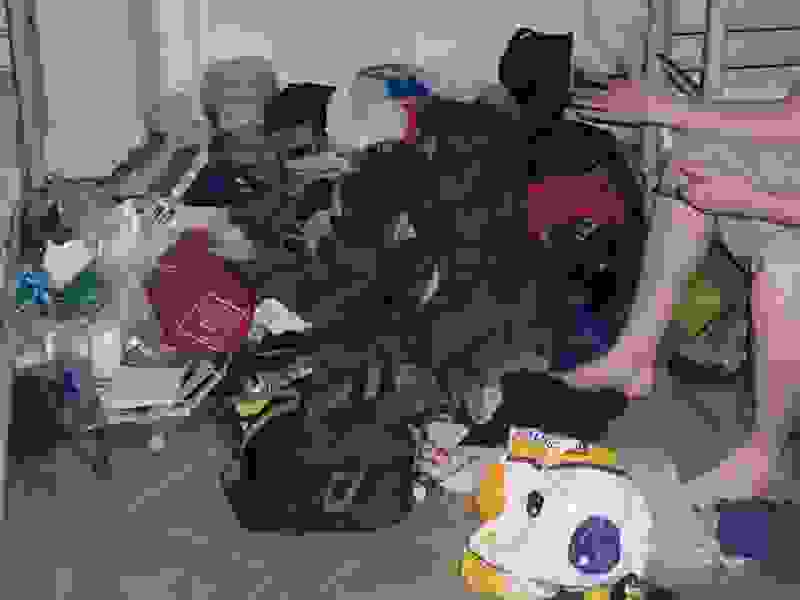
Laundry concerns are an even bigger deal for anyone trying to pack as little as possible (like me). I consider minimizing pack size to be extraordinarily helpful, but the downside is that you’ll be doing laundry far more frequently than someone with a giant monster backpack.
Often I wonder if I’m the only one having crazy concerns like these, as everyone else seems content with the expensive-laundry-status-quo, but it was nice to see a solution to this predicament, in the form of a manual washing machine you can take with you wherever you go.
The Scrubba: A portable, pocket-sized, manual washing machine
The recently designed Scrubba attempts to solve the hostel sink hand-wash ickiness or expensive hotel laundry service problems by giving you your very own hand-powered washing machine, allowing you to get your clothes squeaky clean in just a few minutes.
I was looking forward to trying this out, as I like the option of being able to wash my clothes as needed, whether it’s due to pricey fees or getting stuck somewhere with no laundry facilities.
It’s currently $55, plus shipping costs, and is ultra-portable, scrunching down to the size of a t-shirt, and weighing about 5 ounces (~140 g).
Here’s how tiny it is:
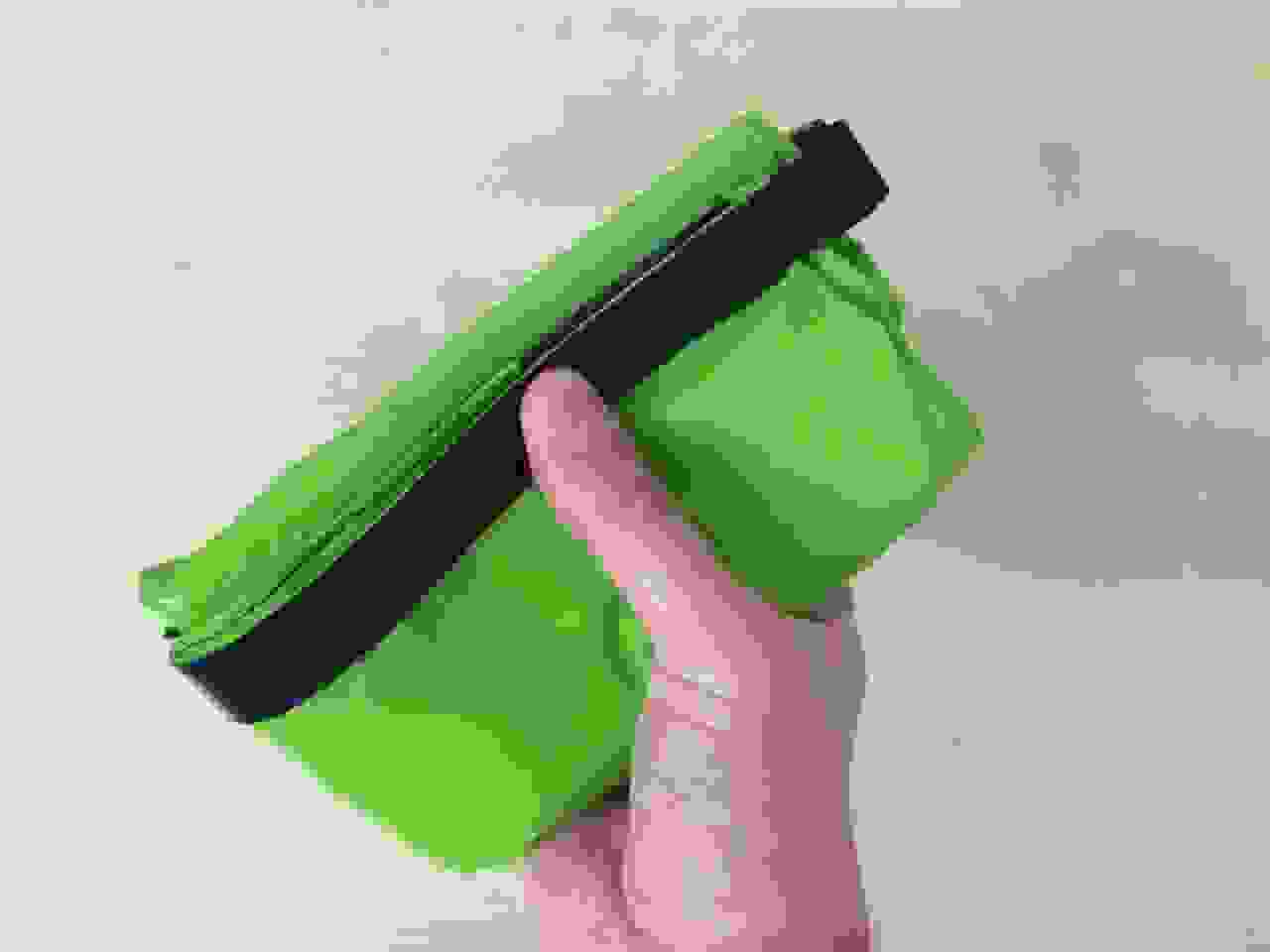
When unfurled, it looks very much like a typical waterproof roll-top dry bag (because that’s what it is), except with the additions of a see-through window, an air release valve, maximum fill lines, and printed instructions.
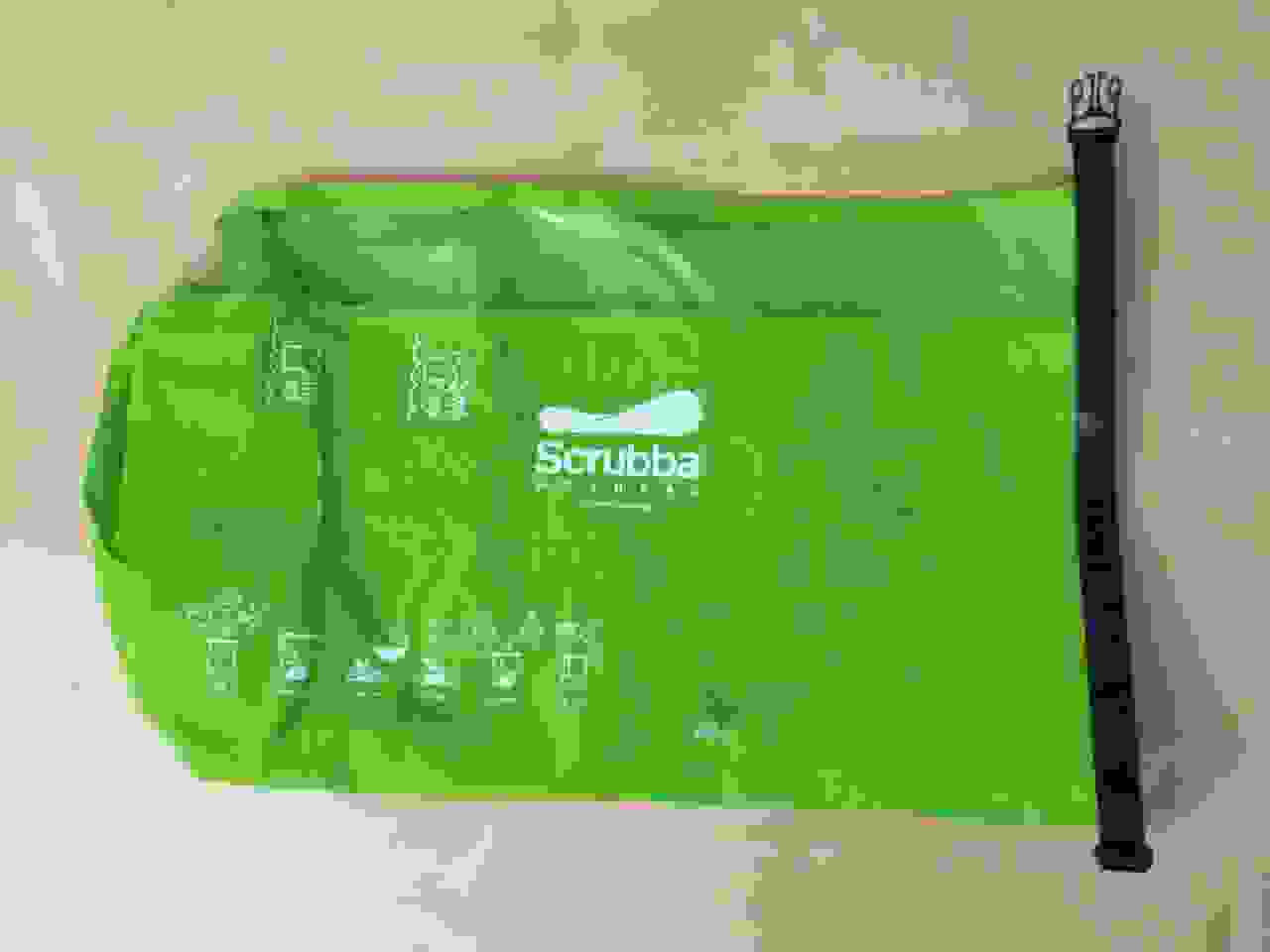
But it’s the inside that’s most significant, as it features a series of rubbery protrusions that act like a washboard. You know, those things people used to hand-wash their clothes before we had machines to do it for us?
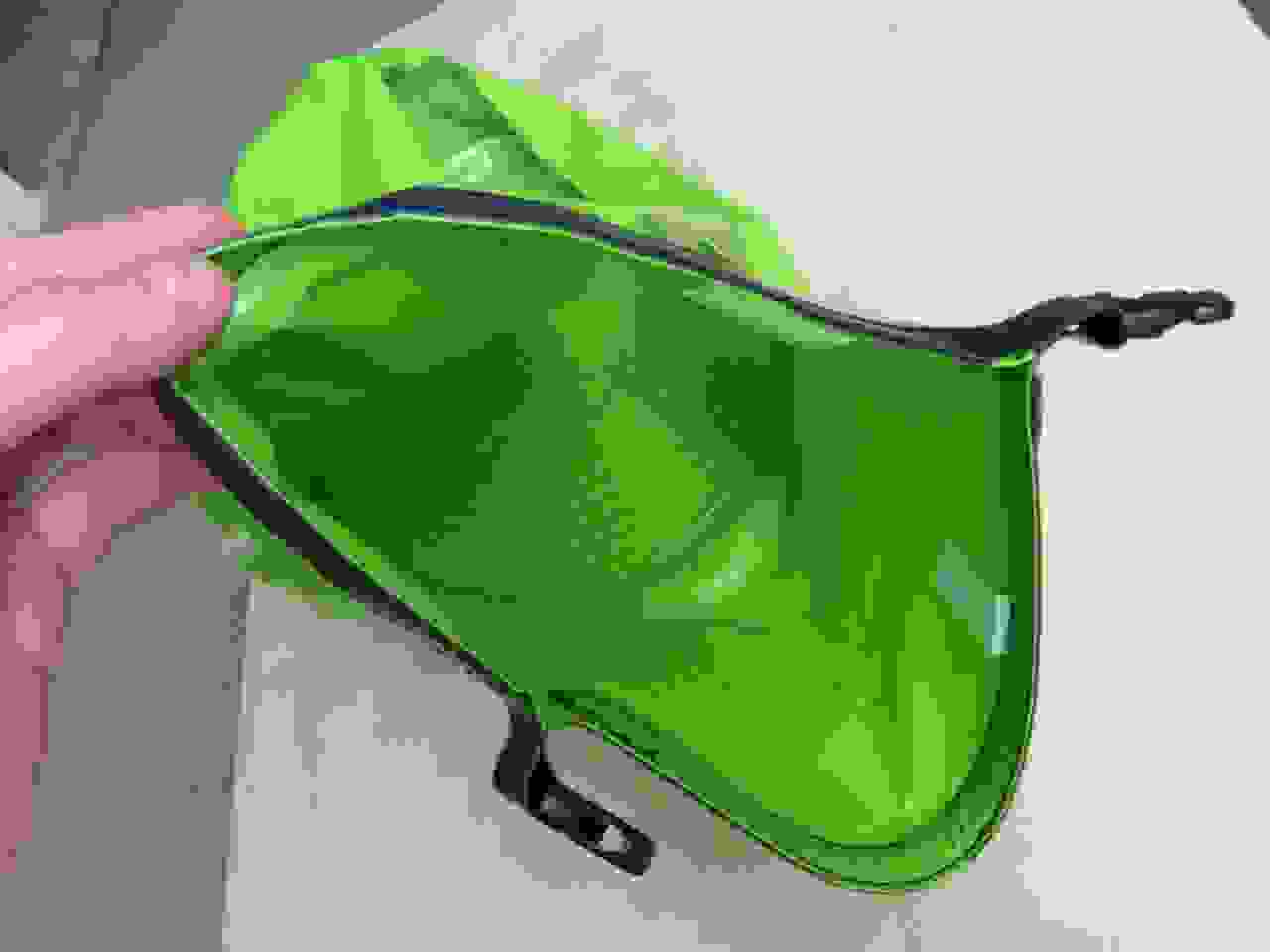
These little bumps significantly increase the agitation and cleaning ability, making it far more efficient and effective than just swirling a t-shirt around in the sink, or holding one up in front of a shower head for a while. With this thing you’re actually scrubbing your clothes, rather than just rinsing them off a bit.
Here’s how it works:
The Scrubba in action
The process is quite simple, and, as mentioned, it has wordless instructions printed right on the outside, so you don’t have to worry about losing an instruction manual.
Step 1: Fill it up
Clothing, soap, and water:
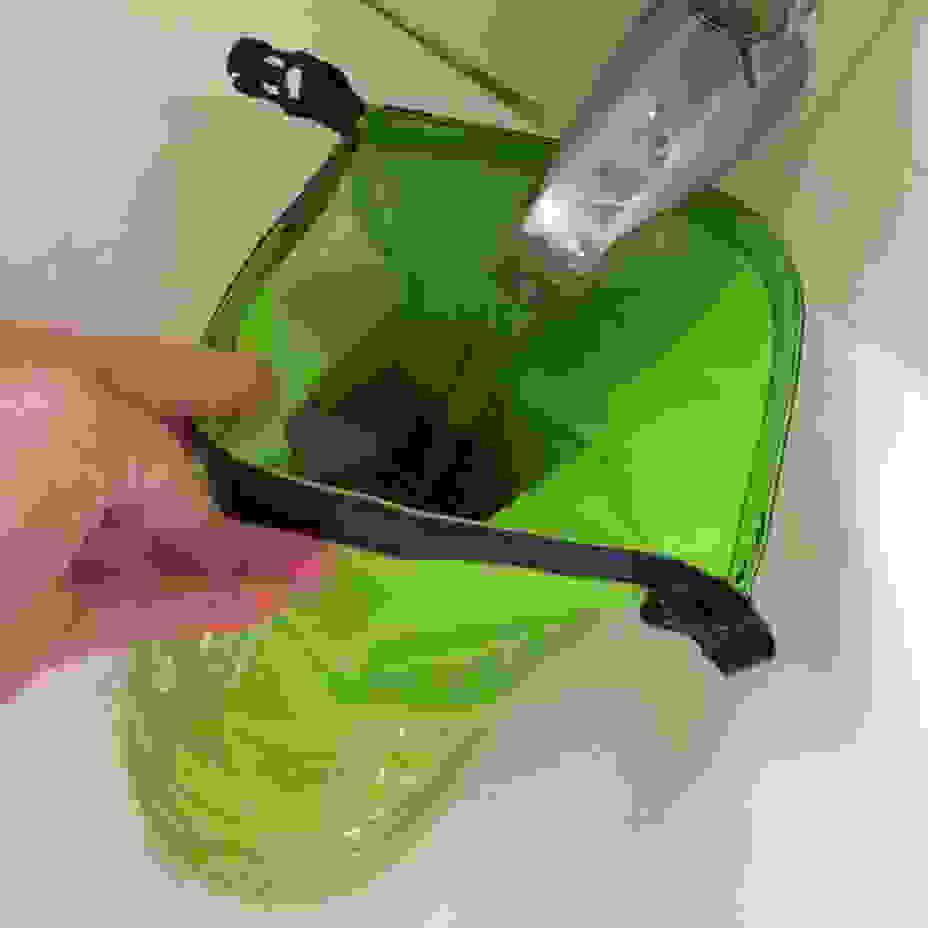
It can handle one set of clothes at a time, or two sets if you’re not washing pants.
By the way, zip up any metal zippers. They have sharp teeth that can bite into things. This is a good idea when using any laundry machine, but even more important here, as you’re shoving clothes against each other (and against the bag) in a vigorous manner.
Scrubba claims you only need a few drops of concentrated soap, as the scrubbing action is handling a lot of the cleaning process. If you think about how much laundry soap you add to a full-size washing machine, you can imagine how little you’d need for just a set or two of clothes.
Step 2: Roll and clip
I usually roll it down pretty far to be safe.
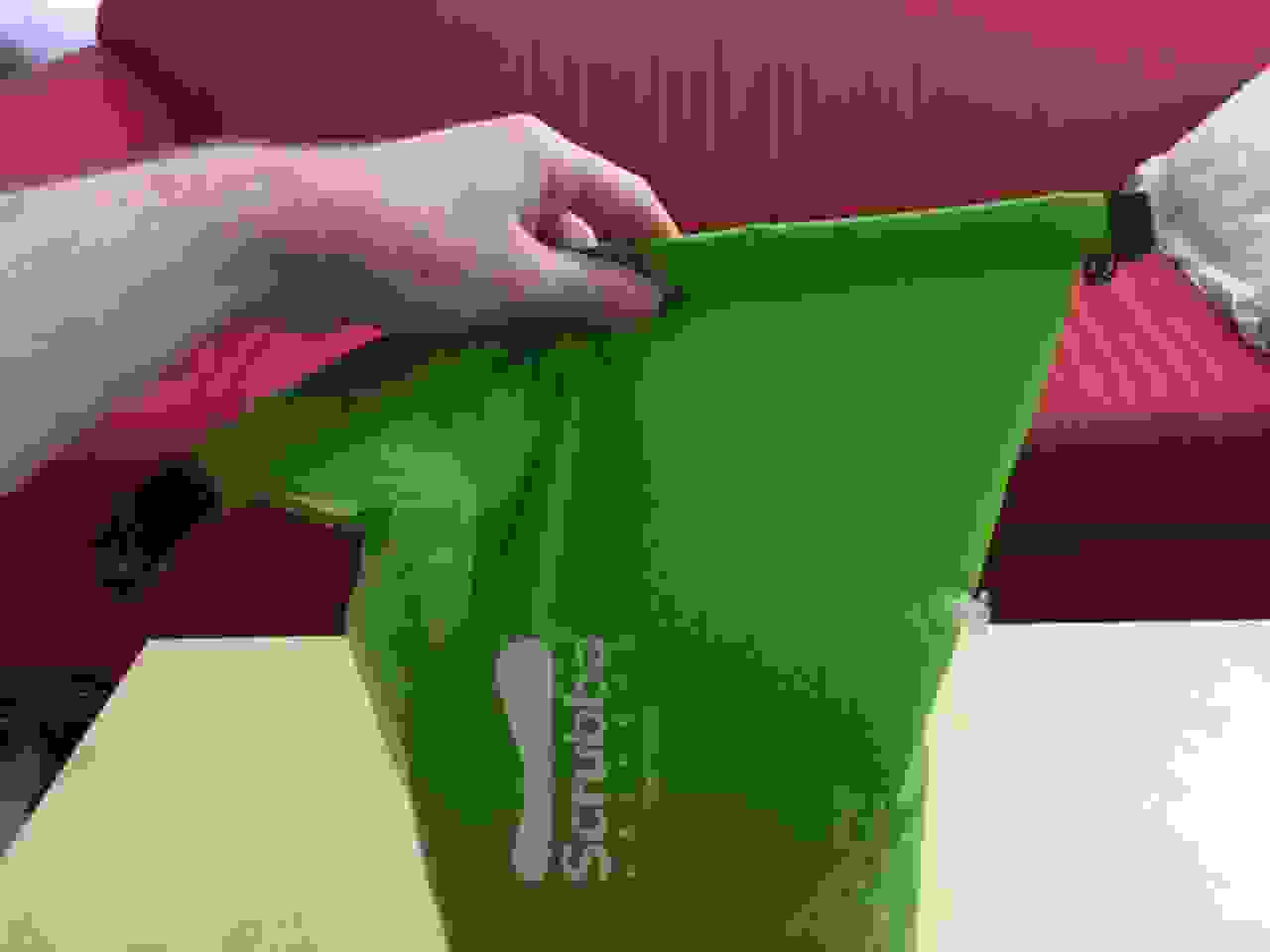
And clip:
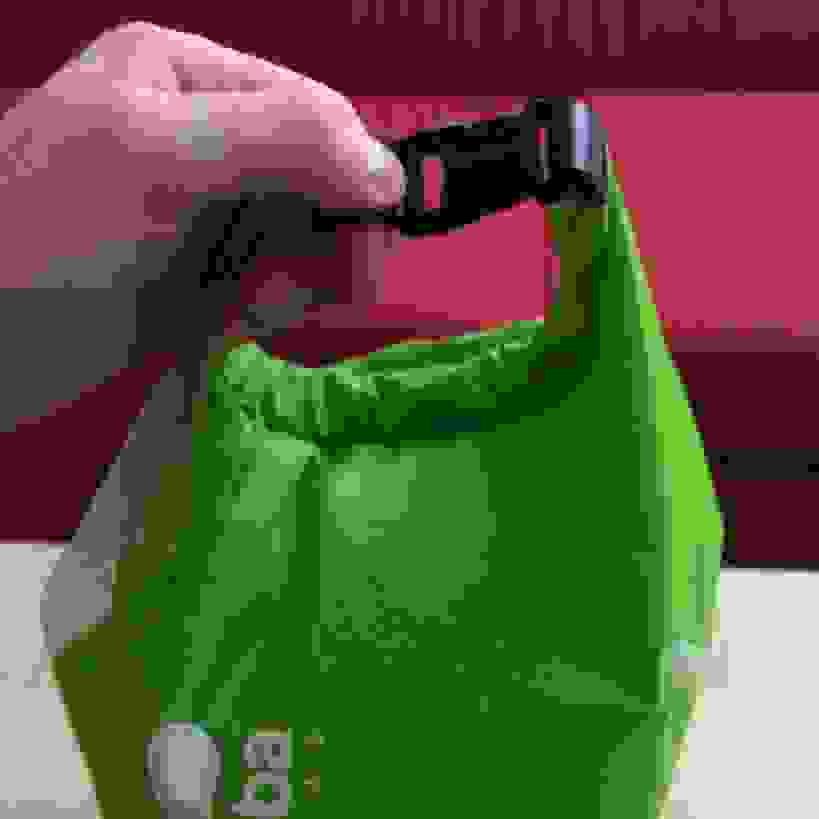
Step 3: Deflate
This removes the excess air, which will allow you to scrub against the washboard more effectively:
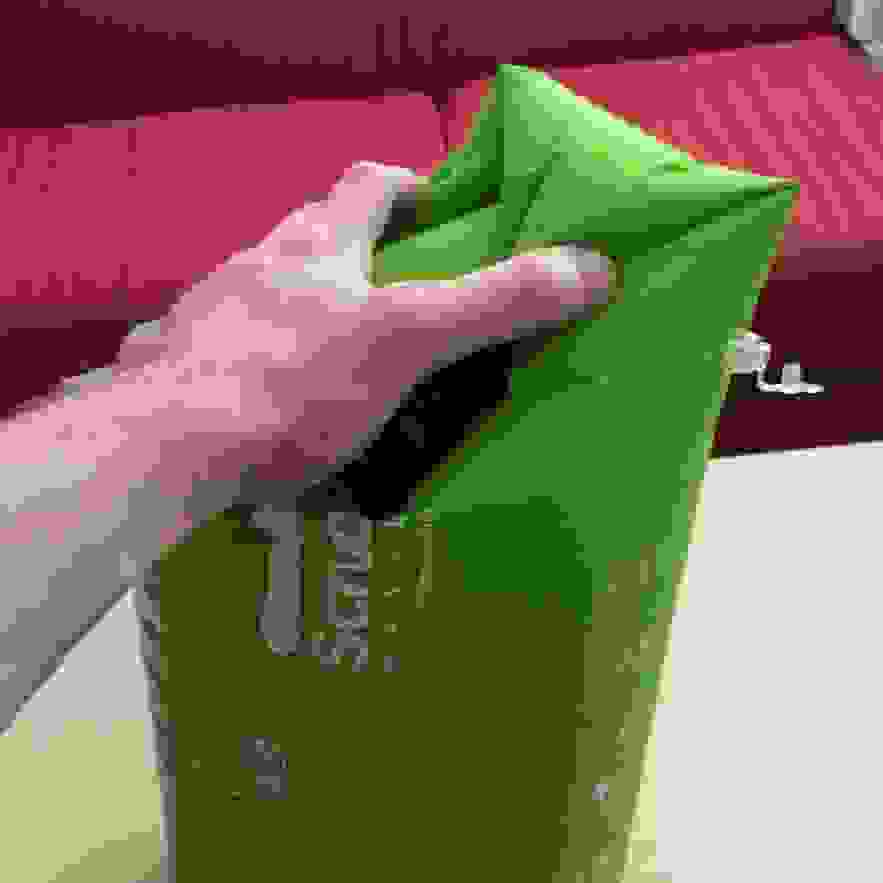
By the way, that pressure release valve is very secure; you actually need to pinch it to allow air to escape (which I wasn’t doing in the photo, due to a lack of hands), so it won’t just leak on its own, even if it’s open.
Step 4: Scrub
You can really feel those ridges in the base of the bag hitting the clothes while you’re washing. The outside of the bag also has a sticky base to hold it in place on a countertop, which is quite helpful during vigorous scrubs.
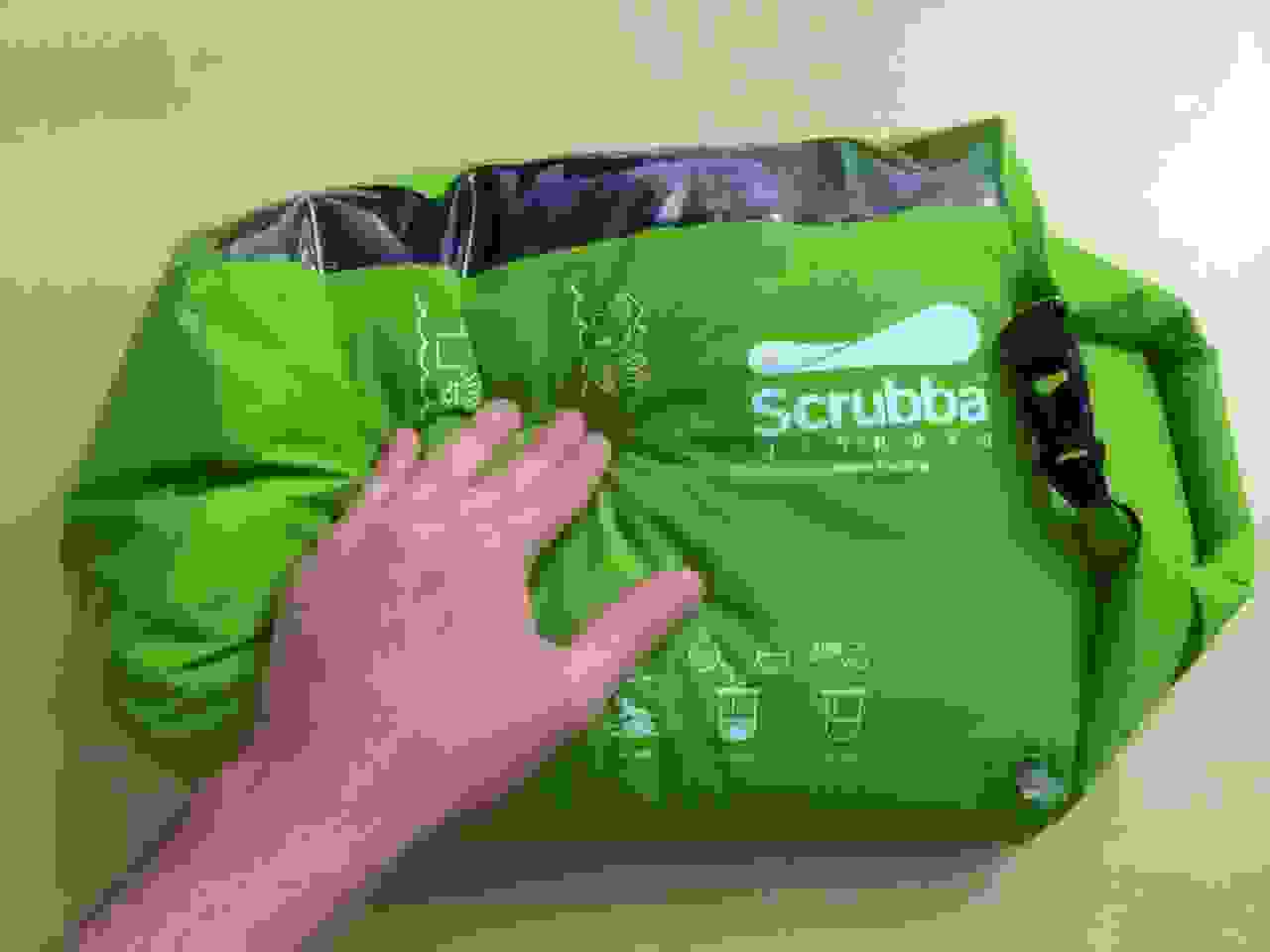
Scrubba recommends washing anywhere from 30 seconds to 3 minutes, depending on how icky your clothes were to begin with. You could alternatively do two quick wash cycles instead of one big one.
Step 5: Drain and rinse
Emptying this thing out is actually the trickiest part of the procedure, as you’ll need to dump the water out, but keep the clothes inside. I found the “upside-down strangle” method to be the most effective:
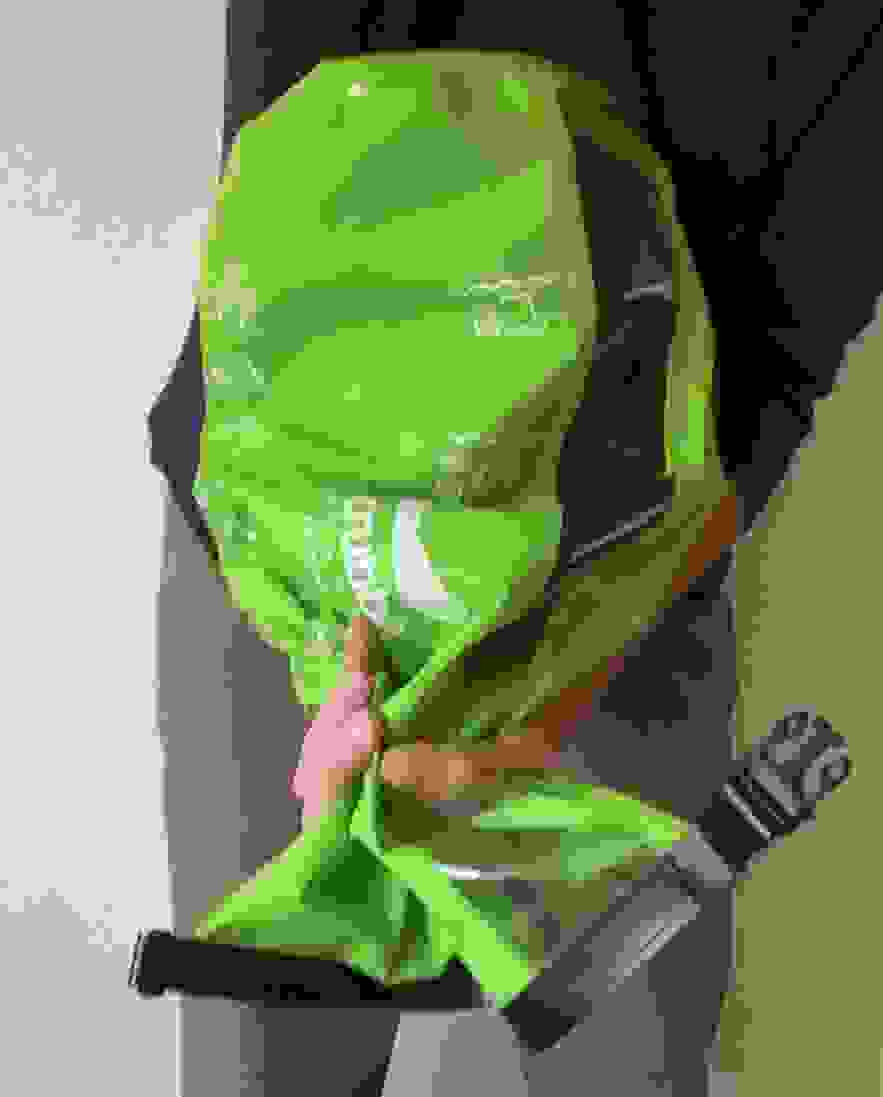
This drains the water through the clothes, so the clothes will catch some of the dirt you’re trying to clean, but that’s what rinse cycles are for. After you refill for the rinse, you can just pull the clothes out from the top, without draining the bag, and wring them out over a sink or shower drain.
Toweling off the inside of the bag will help it dry faster, which is important for mold prevention. You’ll also want to make sure it’s wide open for air-drying, or inside-out.
Step 6: Wring, towel dry and hang
If you’re not familiar with hand washing, you’ll want to wring out as much water from the clothes as you can, but not enough to damage them. I’ve mangled a few t-shirts this way, which is why I prefer the squish method rather than the twist method, though a little twisting is fine.
The towel roll isn’t strictly necessary, but it can cut drying time in half, and will eliminate drips. It’s generally a good idea in colder climates, and also if you have nowhere to hang them but in the shade.
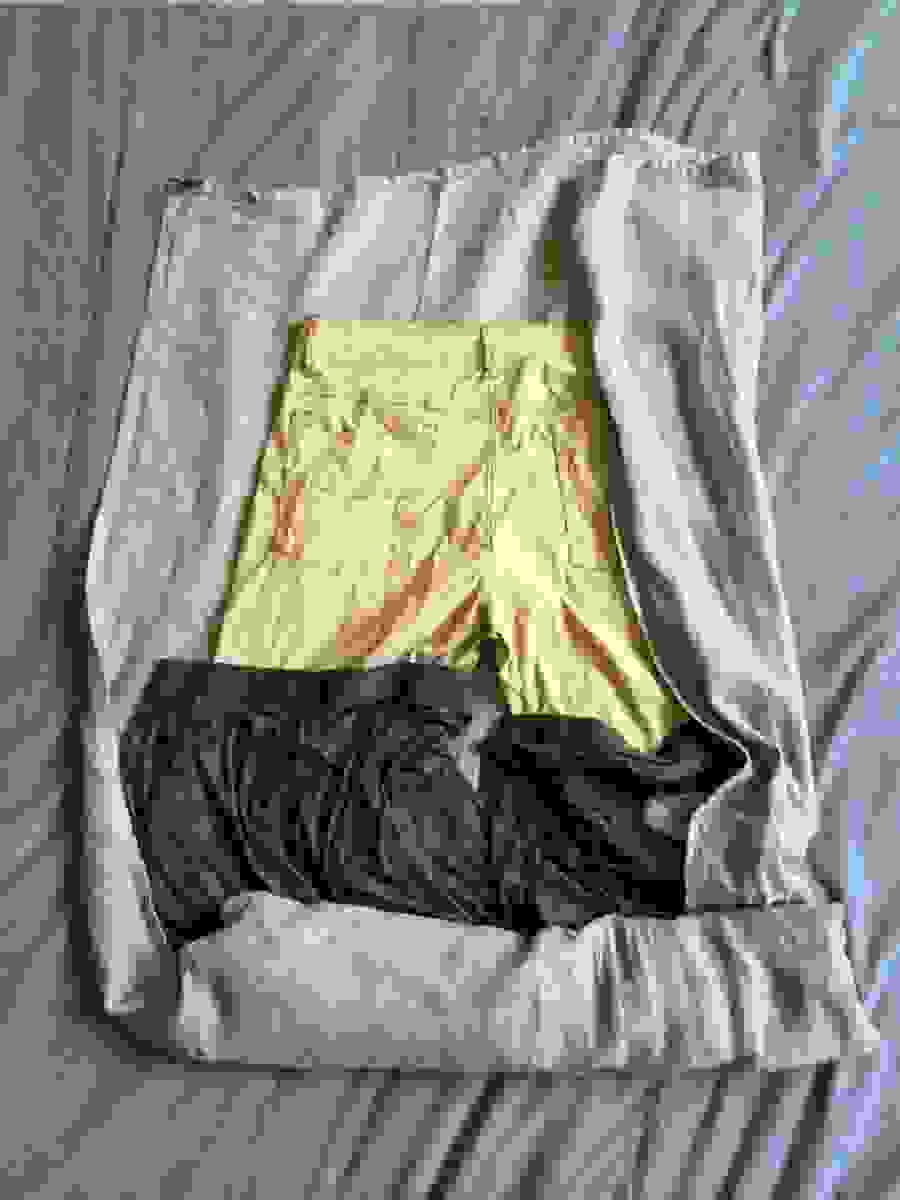
And, finally, hang up the clothes, and you’re done for now.
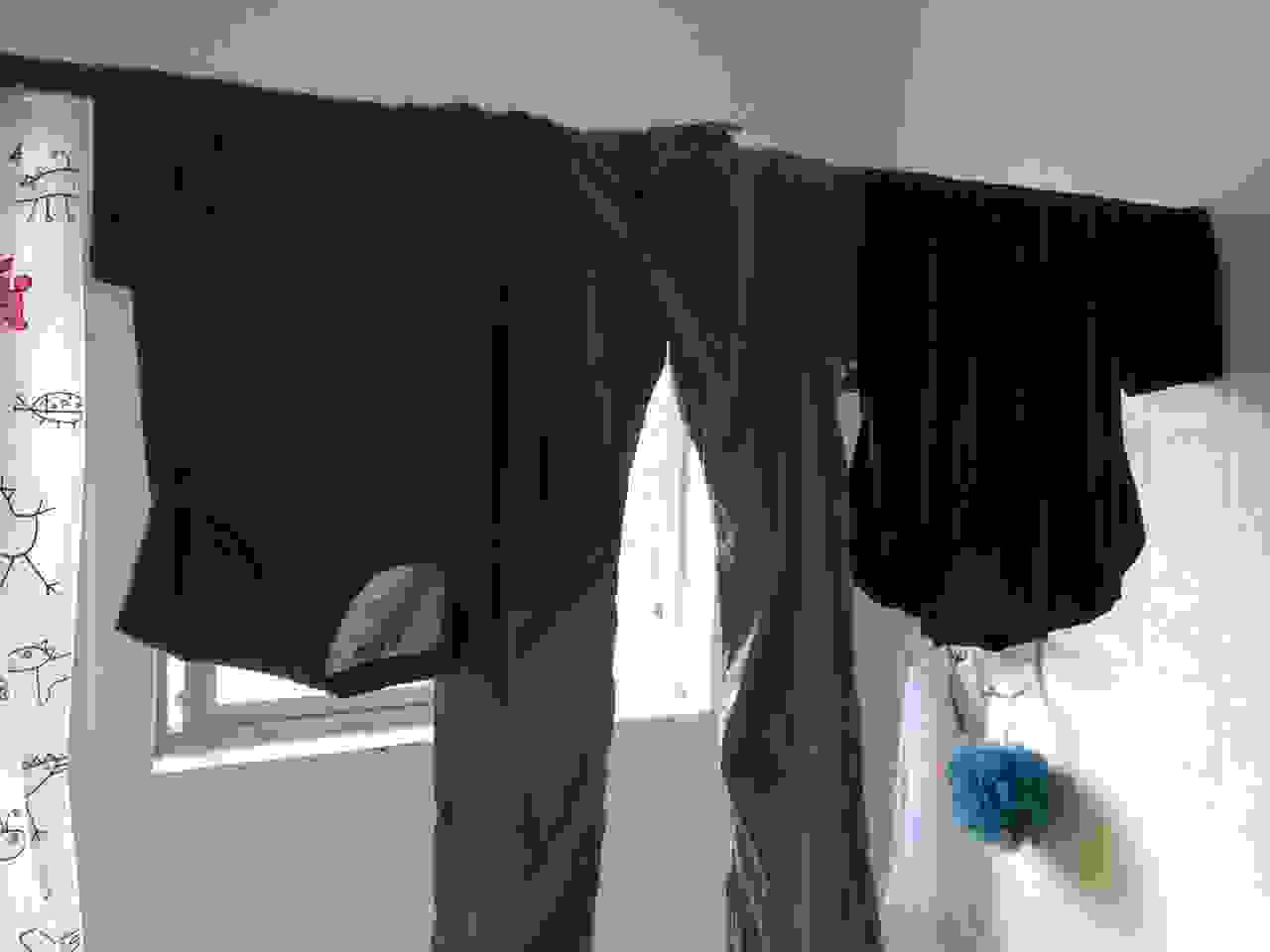
It can take anywhere from 6-36 hours for clothes to dry, depending on how well they were wrung out and towel-dried, how sunny it is, the thickness of the fabric, and so on. It’s good to know more or less how long it’ll take your clothes to dry, so you can plan on doing laundry when you have time for them to dry completely.
Dorky analysis
I have always found constant laundry errands to be a huge nuisance, and I was dreaming of some sort of magical contraption that would reduce the time-consuming process down to a ridiculously quick procedure that I’d only have to do every few days, but I don’t think that’s actually possible.
While it’s true that you only need a few minutes to wash your clothes with the Scrubba, it won’t speed up the wringing, towel rolling, and hang drying steps, so the grand total amount of time might not be significantly reduced. And although it’s true that you can wash several items simultaneously instead of dealing with them one at a time, that saved time is offset by filling, clipping, deflating, and emptying the bag.
By comparison, if you’re doing a sink wash, you can start scrubbing clothes while the sink is filling up, and start wringing them out as the sink is draining, whereas the Scrubba requires you to do those steps separately. And although a shower wash pretty much requires you to wash your clothes one at a time, it doesn’t require any time spent filling and draining a bag, and you’re also (sort of) getting a shower at the same time.
The Scrubba also requires a flat surface for scrubbing, and if there isn’t one in the bathroom, you might find yourself using the floor, or wandering around in search of a table.
But, all that said, it definitely seems to get the clothes a lot cleaner. Sink washing is sort of a swish-around-in-the-water sort of process, as it’s hard to scrub vigorously when it’ll get water everywhere. Shower washing is better for splash prevention, but even with vigorous scrubs, it doesn’t feel like it’s doing much more than a basic rinse.
In contrast, the Scrubba allows you to scrub the hell out of your clothes, getting them as clean as you want, which is a major improvement compared to sink and shower washes. So it won’t necessarily increase the speed of a hand wash, but it’ll definitely increase the quality. And for some people, that might be exactly what they need.
Thus:
Scrubba review conclusions
Good things:
- The Scrubba allows you to hand-wash your clothes anywhere, anytime, as long as you’ve got soap and water, in just a few minutes.
- It’s lightweight, and packs down small.
- It’ll get your clothes a lot cleaner than a sink or shower wash.
- You can do your laundry for free.
- It doubles as a waterproof dry bag.
Potential issues:
- Manual laundry is still going to be a time-consuming process.
- $55 will be a little pricey for some people.
- It’s possible to make your own for maybe half the price, by using a regular dry bag and adding the ridges yourself with some sort of rubbery glue-like substance (though in that case you won’t get the see-through section or the deflation valve).
This is definitely a mix of pros and cons, which will work nicely in certain situations, but might not be quite as helpful in others. Thus:
It’s good for:
- Backpacking through expensive countries, where laundry fees might get annoyingly pricey, especially on longer trips.
- Rural areas that have no laundry facilities at all.
- Washing just one or two items at a time, especially if you need a specific outfit for some reason.
- Road trips or camping trips, where there might not be a laundry machine for miles.
If laundry services cost $5 per load, you’ll start saving money after skipping a dozen laundry cycles, and it certainly won’t stop you from enjoying free laundry services if they happen to be available. I would expect it would therefore be most effective for trips of several months or more, in summer heat, through countries with high laundry prices, where you plan on hand washing to save cash. Backpacking Western Europe in the heat of summer, for example.
But not so good for:
- Traveling through super-cheap countries with readily-available laundry facilities.
- Short trips where you won’t do laundry anyway (duh).
- People who would rather just pay for laundry.
But even in those cases, it might come in handy if all the laundromats are closed for the day, or if you spill coffee all over yourself and need that shirt clean by tomorrow morning.
So I think it’s definitely worth a look for those ultralight backpackers who want a manual washing method that’s more effective than a quick soak in the sink, and it’ll definitely fulfill that requirement. Whether it’s cost-effective or not will depend on the length of the trip, how pricey the country is, and how often you make use of it.
I expect that some people will swear by it, as it can be incredibly useful for certain types of trips, where a pocket-sized, hand-powered washing machine would see constant use, and save lots of money. If that sounds like you, you’ll probably love it.
You can pick it up here.
Update! After a trip through Central America where I used this to wash my clothes, pretty much all the analysis above has been confirmed. You can clean your clothes better, but not faster, than with a shower wash. I would recommend only doing one set of clothes at a time, though if you’re not washing pants, then you can do two. Otherwise it just seems to get too big and you can’t scrub that well. Also, to speed things up, just use more soap, rather than spending more time scrubbing. You’ll tire yourself out after the first 30 seconds, and the scrub will get less and less vigorous thereafter. So just use a bit more soap, and rinse thoroughly.




Clever little device. Here’s to hoping it drops in price (or gets sold by Amazon) sometime in the near future.
Eytan:
I am one of your followers and was glad to see that you reviewed the Scrubba. After seeing it on “Rachel Rae”, I bought one and took it along to Europe this spring. I paid $65 for my Scrubba (direct from Scrubba), so I’m glad to see the price has dropped to $55.
When packing, I am a minimalist to the nth degree and pretty much stick to travel clothing that is constructed of synthetic materials except for wool socks or a pair of jeans. I had originally planned to take a 2.5 gallon plastic freezer bag for those times when a sink stopper was not available for hand washing. I thought the Scrubba sounded like a great idea especially if it cleaned better than hand washing.
I used the Scrubba several times but didn’t think it cleaned better than hand washing. I think the key to washing clothes is to push as much water as possible through the fabric. When washing clothes in the sink, I found that kneading the clothes, as if making bread, cleaned just as well. Wished I had saved my money. The Scrubba also takes a bit more packing space than the freezer bag.
The Scrubba mostly uses less water than a sink wash (since a sink would probably be bigger), but after having used it for a month, I think adding extra soap is important, particularly for synthetic clothing that can hold odors. It’s still something I consider an iffy maybe, rather than a must-have. Doing two cycles helps quite a bit too.
Certainly an interesting product. Not likely something I would buy in spite of the fact that I love gadgets. In the end it seems like one more thing to carry. Most clothes really are not dirty in the sense they have ground in dirt. Generally what is really happening is body oils and smells are getting washed out of the clothes, at least for a European style vacation versus actual backpacking in a more remote area. I do have to say the idea is clever, so for the right trip it might just make sense.
Yeah, it’s certainly not useful if you have laundry machines readily available, or a river or something like that. But I expect in certain situations it could be quite useful.
I think one subtle point you missed is that it works well when you have shared bathrooms or no bath at all. Sink / shower laundry ties up the bath the entire time you are doing laundry. The Scrubba lets you share the bath with others because you fill up the bag, walk away from the sink, then come back for the rinse cycle. Your roommates will thank you.
Do you turn the bag inside out and wipe it down to dry it?
Have you tried using it as a dry bag for water activities?
You can turn it inside out to dry it, but most of the time I just stuffed a towel inside and pulled it back out, and that dried it enough that I could hang it up and it would air-dry the rest. Remember that after splashing around in the sink for a while, the outside will be wet too, so it kind of doesn’t matter if it’s inside-out or not. You just have to hang it in a way that’ll let air flow all around.
Maybe it could also double as a compression sack.
Probably not compression, but it definitely doubles as a dry bag for protecting important gear from the rain.
I’ll bet there is something out there with those little bumps on it, maybe a toy, or piece of fabric or plastic, that could easily be put in a sink or plastic bag to wash the clothes against. Not the same exactly, but wouldn’t cost $55+.
Actually you can manually add those dots yourself, on the inside of a regular dry bag (Seam Grip apparently works well for this), but I wanted to give this a try anyway. It’s cheaper, though you don’t get the air release valve.
Hi Eytan,
Earlier this month, my girlfriend and I went to Chapada Diamantina in Brazil for two weeks to get away and do some hiking. The several pousadas and hotels we stayed at had bathroom sinks too small to comfortably wash a shirt or pants in, none of which had a plug. During our trip I actually drafted a message intended to be sent to you or Doug Dyment about a solution for laundry washing in a bag, but you answered my question before I could ask it.
I think i’ll pick one of these up. The price is steep, but I would have gladly paid that much during this last trip on the Sunday when I couldn’t find a laundry service that was open, or on the next day when the laundry services in town that had a dryer quoted a lead time of 36 hours. The additional bag weight is justified when you consider it’s no greater than a sink stopper. It might also make a decent dirty clothes bag.
Thanks,
Ryan
Hi Eytan
I’ve been following your blog for a while and appreciate the insights I get from your gear reviews :)
I’m tempted to try the scrubba bag for the increased cleaning ability, since sometimes my hand washes aren’t as effective as a machine wash. Thanks for another informative review
An alternative I’m considering to the scrubber is one of these cheaper waterproof bags, but I’m not sure this will clean so well without the little bumps inside:
http://www.amazon.co.uk/gp/aw/d/B000BT80VG/ref=mp_s_a_1_1?qid=1409844103&sr=8-1&pi=SX200_QL40
You can actually make your own by flipping the bag inside out and adding the little bumps yourself, with some sort of rubbery glue. I hear Seam Grip works well. You won’t get the air valve, so you have to deflate it as much as possible before the roll and clip stage, but it’ll work. Plus you can add dots all around the bag, rather than just along the bottom. Also, you can make up for the lack of dots with extra soap. It might be worth trying this once or twice with a regular bag before adding the dots, just to see how it works out. You can always use it as a dry bag if you change your mind.
there are quite a few valve dry bags around if you search. This is one type – the kodiak from seal line (even has the window)
http://www.cascadedesigns.com/sealline/dry-bags/kodiak-dry-bag/product
cheers
David
I’m curious how large the Scrubba is. Could you estimate its volume in liters?
Thanks!
Approximately 15 liters, give or take, depending on how many folds you do when you close it up at the top.
Thanks!
I need something like this. In the past I’ve used large Ziploc bags with washing detergent, but I didn’t feel like they got my clothes clean enough. On the other hand, the price is really high for the amount I travel. I was trying to figure out if I could improvise something with one of my existing dry bags.
However, the Scrubba may fold up more compactly than a dry bag…
Well, the Scrubba is a dry bag, a 15 liter one, more or less, so if you have a 15 liter dry bag, it should fold down to a similar size. In fact the ridges on the inside make the Scrubba, since it can’t be perfectly flattened (although the ridges are clearly there for a reason). But if you’re still trying to budget, I’ve seen people make their own little ridges or dots in a regular dry bag by using something called Seam Grip.
Well, I ended up buying one of those Ultra-Sil drybags. It DOES fold down very small, but I’m really wondering if it is reliably waterproof and won’t leak. Perhaps I should have gotten the Scrubba! Well, time will tell…